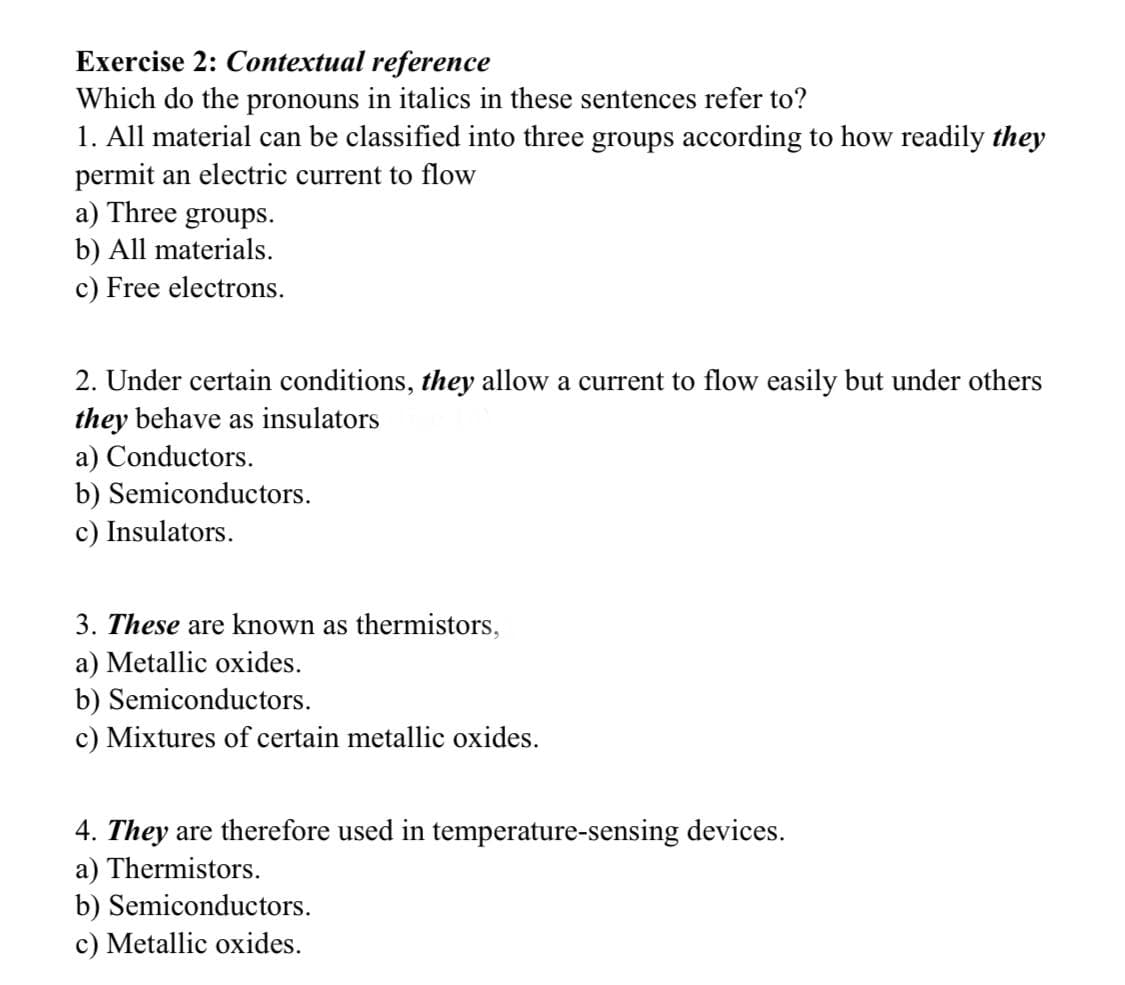Exercise 2: Contextual reference Which do the pronouns in italics in these sentences refer to? 1. All material can be classified into three groups according to how readily they permit an electric current to flow a) Three groups. b) All materials. c) Free electrons. 2. Under certain conditions, they allow a current to flow easily but under others they behave as insulators a) Conductors. b) Semiconductors. c) Insulators. 3. These are known as thermistors, a) Metallic oxides. b) Semiconductors. c) Mixtures of certain metallic oxides.
Exercise 2: Contextual reference Which do the pronouns in italics in these sentences refer to? 1. All material can be classified into three groups according to how readily they permit an electric current to flow a) Three groups. b) All materials. c) Free electrons. 2. Under certain conditions, they allow a current to flow easily but under others they behave as insulators a) Conductors. b) Semiconductors. c) Insulators. 3. These are known as thermistors, a) Metallic oxides. b) Semiconductors. c) Mixtures of certain metallic oxides.
Introductory Circuit Analysis (13th Edition)
13th Edition
ISBN:9780133923605
Author:Robert L. Boylestad
Publisher:Robert L. Boylestad
Chapter1: Introduction
Section: Chapter Questions
Problem 1P: Visit your local library (at school or home) and describe the extent to which it provides literature...
Related questions
Question
i need the answer quickly

Transcribed Image Text:Exercise 2: Contextual reference
Which do the pronouns in italics in these sentences refer to?
1. All material can be classified into three groups according to how readily they
permit an electric current to flow
a) Three groups.
b) All materials.
c) Free electrons.
2. Under certain conditions, they allow a current to flow easily but under others
they behave as insulators
a) Conductors.
b) Semiconductors.
c) Insulators.
3. These are known as thermistors,
a) Metallic oxides.
b) Semiconductors.
c) Mixtures of certain metallic oxides.
4. They are therefore used in temperature-sensing devices.
a) Thermistors.
b) Semiconductors.
c) Metallic oxides.
Expert Solution
This question has been solved!
Explore an expertly crafted, step-by-step solution for a thorough understanding of key concepts.
Step by step
Solved in 4 steps with 3 images

Knowledge Booster
Learn more about
Need a deep-dive on the concept behind this application? Look no further. Learn more about this topic, electrical-engineering and related others by exploring similar questions and additional content below.Recommended textbooks for you

Introductory Circuit Analysis (13th Edition)
Electrical Engineering
ISBN:
9780133923605
Author:
Robert L. Boylestad
Publisher:
PEARSON

Delmar's Standard Textbook Of Electricity
Electrical Engineering
ISBN:
9781337900348
Author:
Stephen L. Herman
Publisher:
Cengage Learning

Programmable Logic Controllers
Electrical Engineering
ISBN:
9780073373843
Author:
Frank D. Petruzella
Publisher:
McGraw-Hill Education

Introductory Circuit Analysis (13th Edition)
Electrical Engineering
ISBN:
9780133923605
Author:
Robert L. Boylestad
Publisher:
PEARSON

Delmar's Standard Textbook Of Electricity
Electrical Engineering
ISBN:
9781337900348
Author:
Stephen L. Herman
Publisher:
Cengage Learning

Programmable Logic Controllers
Electrical Engineering
ISBN:
9780073373843
Author:
Frank D. Petruzella
Publisher:
McGraw-Hill Education

Fundamentals of Electric Circuits
Electrical Engineering
ISBN:
9780078028229
Author:
Charles K Alexander, Matthew Sadiku
Publisher:
McGraw-Hill Education

Electric Circuits. (11th Edition)
Electrical Engineering
ISBN:
9780134746968
Author:
James W. Nilsson, Susan Riedel
Publisher:
PEARSON

Engineering Electromagnetics
Electrical Engineering
ISBN:
9780078028151
Author:
Hayt, William H. (william Hart), Jr, BUCK, John A.
Publisher:
Mcgraw-hill Education,